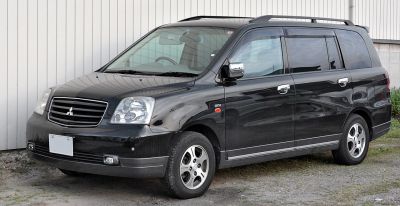 1998 Toyota Nadia (SXN10) Dimensions, Size & Specs
1998 Toyota Nadia (SXN10) Dimensions, Size & Specs
Measurements of the 1998 Toyota Nadia, engineered for optimal performance and comfort
| Dimensions | |
|---|---|
| Length: | 4435 mm174.6 in14.6 ft |
| Width: | 1695 mm66.7 in5.6 ft |
| Height: | 1625 mm64.0 in5.3 ft |
| Trunk Capacity: | 810 liter28.6 cu ft |
| Weight Specifications | |
| Curb Weight: | 1320-1370 kg2910-3020 lbs |
| Maximal permitted Weight: | 1595 kg3516 lbs |
| Tire Specifications | |
| Tire Sizes: |
|
The Toyota Nadia (SXN10), produced from 1998 to 2003, is a versatile minivan designed primarily for family and urban use. Measuring 4435 mm (174.6 inches) in length, 1695 mm (66.7 inches) in width, and standing 1625 mm (64 inches) tall, this model offers a compact yet roomy footprint suitable for navigating city streets while still providing ample cabin space. The curb weight ranges between 1320 to 1370 kg (2910 to 3020 lbs), with a maximum permissible weight of 1595 kg (3515 lbs), balancing efficiency with decent payload capacity. Its luggage compartment can hold up to 810 liters (28.6 cubic feet), making it practical for carrying daily essentials or family luggage on trips. Factory-equipped tire sizes include 195/65 R14 and 195/60 R15 H, reflecting moderate performance and comfort for typical minivan applications. Overall, the Toyota Nadia (SXN10) stands out as a compact minivan offering a good mix of space, efficiency, and maneuverability, ideal for small families or drivers seeking a reliable multipurpose vehicle in the late 1990s to early 2000s.
Discover the standout features that make the 1998 Toyota Nadia a leader in its class
Have a question? Please check our knowledgebase first.
The Toyota Nadia (SXN10), produced from 1998 to 2003, features a length of 4435 mm (174.6 inches), a width of 1695 mm (66.7 inches), and a height of 1625 mm (64 inches). These dimensions position it firmly within the compact to mid-size minivan category, offering a balanced footprint for urban and suburban environments. Its relatively moderate width aids in maneuverability, while the height supports spacious interior headroom, making it practical for family or group travel.
The curb weight of the Toyota Nadia (SXN10) ranges between 1320 kg (2,910 lbs) and 1370 kg (3,020 lbs), depending on the model and equipment level. The maximum weight capacity is rated at 1595 kg (3,517 lbs), which includes passengers, cargo, and additional load. This relatively light to moderate weight supports efficient fuel consumption and nimble handling for a minivan of its size. The maximum weight ensures adequate carrying capacity, making it suitable for family use or transporting goods without compromising safety or stability.
The Toyota Nadia (SXN10), with a length of 4435 mm (174.6 inches) and width of 1695 mm (66.7 inches), generally fits within the confines of a standard single-car garage. Typical garage dimensions are about 6 meters (19.7 feet) in length and 3 meters (9.8 feet) in width, providing enough space to accommodate the vehicle comfortably with room to open doors. However, it is recommended to consider some extra clearance for ease of parking, storage, and movement around the vehicle.
At 4435 mm (174.6 inches), the Toyota Nadia is competitively sized among compact minivans of its era. For comparison, competitors like the Honda Stream and Nissan Prairie had similar lengths ranging from roughly 4300 mm to 4550 mm (169 to 179 inches). This length allows the Nadia to offer relatively spacious interior room and cargo capacity while maintaining maneuverability and parking convenience in urban areas. It strikes a good balance between compactness and passenger comfort.
The Toyota Nadia (SXN10) boasts a generous luggage capacity of 810 liters (approximately 28.6 cubic feet) when the seats are configured for maximum cargo space. This makes it versatile for family road trips, daily errands, or transporting large items. The ample cargo volume, combined with the flexible seating arrangements typical of minivans, means that users can easily adjust to different passenger and cargo needs without compromising comfort or utility.
The Toyota Nadia (SXN10) comes equipped with tire sizes of 195/65 R14 and 195/60 R15 H, depending on the trim and model specification. The 195 mm width offers good road grip and stability, while the varied sidewall height (65 or 60 series) and rim diameters (14 or 15 inches) affect ride comfort and handling. The slightly taller sidewalls on the 14-inch tires typically provide a softer ride, which is advantageous for a family-oriented vehicle focusing on comfort.
The Toyota Nadia (SXN10) was introduced without a direct predecessor as it was a relatively unique minivan offering in Toyota's lineup during its production period from 1998 to 2003. However, when compared dimensionally to other Toyota minivans before its time, like the Toyota TownAce or LiteAce, the Nadia is more compact with better urban adaptability. Its height and width provide a more modern and comfortable passenger environment without the bulk of older minivans, making it a more convenient choice for smaller families.
The Toyota Nadia (SXN10) competes closely with other compact minivans such as the Honda Stream and the Mazda Demio MPV from the same era. Dimensionally, with its length of 4435 mm (174.6 inches) and width of 1695 mm (66.7 inches), it is slightly longer but narrower compared to some rivals. This permits relatively spacious interior space without sacrificing maneuverability. Its height of 1625 mm (64 inches) offers comparable headroom. Overall, the Nadia stands out for balancing size, interior utility, and ease of driving in urban environments.
The Toyota Nadia (SXN10) measures 1625 mm (64 inches) in height and 1695 mm (66.7 inches) in width, which are modest for a minivan, especially given its production era. The narrower width helps the vehicle to navigate tight city streets, fit into narrow parking spaces, and easily use standard parking lanes. The height provides sufficient headroom and a commanding driving position without making the vehicle excessively tall, which enhances stability and reduces aerodynamic drag.
Weighing between 1320 kg (2,910 lbs) and 1370 kg (3,020 lbs) when curb weight is considered, the Toyota Nadia (SXN10) is relatively lightweight for a compact minivan. This lighter weight contributes to better fuel efficiency and more agile handling compared to heavier competitors, which often weigh upwards of 1500 kg (3,300 lbs). The maximum weight of 1595 kg (3,517 lbs) also provides a solid load capacity, balancing performance with practical usability for everyday family transportation.
Discover similar sized cars.

| Production: | 2019-present |
|---|---|
| Model Year: | 2019 |
| Length: | 4510 mm177.6 in |
| Width: | 1750 mm68.9 in |
| Height: | 1695 mm66.7 in |

| Production: | 2015-present |
|---|---|
| Model Year: | 2015 |
| Length: | 4522 mm178.0 in |
| Width: | 1767 mm69.6 in |
| Height: | 1697 mm66.8 in |

| Production: | 2012-2015 |
|---|---|
| Model Year: | 2012 |
| Length: | 4498 mm177.1 in |
| Width: | 1751 mm68.9 in |
| Height: | 1697 mm66.8 in |

| Production: | 2021-present |
|---|---|
| Model Year: | 2021 |
| Length: | 4496 mm177.0 in |
| Width: | 1754 mm69.1 in |
| Height: | 1682 mm66.2 in |

| Production: | 2000-2006 |
|---|---|
| Model Year: | 2000 |
| Length: | 4460 mm175.6 in |
| Width: | 1695 mm66.7 in |
| Height: | 1650-1695 mm65.0-66.7 in |

| Production: | 2017-2021 |
|---|---|
| Model Year: | 2018 |
| Length: | 4475 mm176.2 in |
| Width: | 1750 mm68.9 in |
| Height: | 1700 mm66.9 in |

| Production: | 2017-present |
|---|---|
| Model Year: | 2017 |
| Length: | 4498-4522 mm177.1-178.0 in |
| Width: | 2004 mm78.9 in |
| Height: | 1682 mm66.2 in |

| Production: | 2017-present |
|---|---|
| Model Year: | 2017 |
| Length: | 4498 mm177.1 in |
| Width: | 2004 mm78.9 in |
| Height: | 1679-1714 mm66.1-67.5 in |
